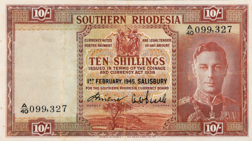Southern Rhodesian pound
 10/– banknote from 1945 | |
| Unit | |
|---|---|
| Unit | pound |
| Plural | pounds |
| Symbol | £ |
| Denominations | |
| Subunit | |
| 1⁄20 | shilling |
| 1⁄240 | penny |
| Plural | |
| penny | pence |
| Symbol | |
| shilling | s or /– |
| penny | d |
| Banknotes | 5/–, 10/–, £1, £5, £10 |
| Coins | 1⁄2d, 1d, 3d, 6d, 1/–, 2/–, 2/6 |
| Demographics | |
| User(s) | Southern Rhodesia |
| Issuance | |
| Central bank |
|
| Valuation | |
| Pegged with | sterling at par |
| This infobox shows the latest status before this currency was rendered obsolete. | |
The pound was the currency of Southern Rhodesia. It also circulated in Northern Rhodesia and Nyasaland. The pound was subdivided into 20 shillings, each of 12 pence.
History[edit]
From 1896, private banks issued notes denominated in £sd equal to sterling. In 1932, a distinct coinage was introduced. In 1938, the Southern Rhodesia Currency Board was established and took over the issuance of paper money the following year. Southern Rhodesia, Northern Rhodesia and Nyasaland joined in 1953 to form the Federation of Rhodesia and Nyasaland, which continued to use the Southern Rhodesian pound until 1955 when coins were introduced for the Rhodesia and Nyasaland pound. 1955 also saw the Southern Rhodesia Currency Board renamed the Central Africa Currency Board. In 1956, the first paper money of the Rhodesia and Nyasaland pound was introduced, completing the transition.
Coins[edit]
In 1932, .925 fineness silver coins were introduced in denominations of 3d, 6d, 1/–, 2/–, and 2/6. These were followed in 1934 by holed, cupro-nickel 1⁄2d and 1d coins. In 1942, bronze replaced cupro-nickel, whilst the silver coins were debased to .500 fineness in 1944 and replaced by cupro-nickel in 1947. Coins were issued until 1954. In 1953 a 5/– coin of .500 fineness (.45 ounce actual silver weight) was minted to commemorate the centennial of the birth of Cecil Rhodes. 124,000 were produced for circulation, plus 1500 minted as Proof coinage.
Banknotes[edit]
In 1896, the Salisbury branch of the Standard Bank of South Africa introduced the first Southern Rhodesian banknotes, in denominations of £1 and £5. This bank later issued 10/– notes. The Bank of Africa, Barclays Bank and the National Bank of South Africa also issued notes. These private bank issues ended in 1938.
In 1939, the Southern Rhodesia Currency Board introduced 10/–, £1 and £5 notes, followed by 5/– notes between 1943 and 1948 and £10 in 1953. In 1955, the Central Africa Currency Board issued notes in denominations of 10/–, £1, £5 and £10.
| Pick No. |
Image | Value | Dimensions | Main colour | Description | Date of | ||||||
|---|---|---|---|---|---|---|---|---|---|---|---|---|
| Obverse | Reverse | Obverse | Reverse | Watermark | printing | issue | withdrawal | |||||
| 8a | 
|

|
5/– | Brown | King George VI | 5/- | None | 1943 - 1945 | 1 January 1943 | |||
| 8b | 
|

|
5/– | 115 × 69 mm | Brown | King George VI | 5/- | None | 1945 - 1952 | 1 February 1945 | ||
| 9 | 
|

|
10/– | Brown | Eastern Highlands and King George VI | Victoria Falls | Cecil John Rhodes | 1939 - 1952 | 15 December 1939 | |||
| 10 | 
|

|
£1 | Green | King George VI | Great Zimbabwe | Cecil John Rhodes | 1939 - 1952 | 15 December 1939 | |||
| 11 | 
|

|
£5 | Blue | Mining and King George VI | Victoria Falls | Cecil John Rhodes | 1939 - 1952 | 15 December 1939 | |||
| Pick No. |
Image | Value | Dimensions | Main colour | Description | Date of | ||||||
|---|---|---|---|---|---|---|---|---|---|---|---|---|
| Obverse | Reverse | Obverse | Reverse | Watermark | printing | issue | withdrawal | |||||
| 12 | 
|

|
10/– | 132 × 75 mm | Brown | Eastern Highlands and Queen Elizabeth II | Victoria Falls | Cecil John Rhodes | 1952 - 1956 | 1 December 1952 | ||
| 13 | 
|

|
£1 | 148 × 82 mm | Green | Queen Elizabeth II | Great Zimbabwe | Cecil John Rhodes | 1952 - 1956 | 1 December 1952 | ||
| 14 | 
|

|
£5 | 160 × 88 mm | Blue | Mining and Queen Elizabeth II | Victoria Falls | Cecil John Rhodes | 1953 - 1956 | 1 January 1953 | ||
| 15 | 
|

|
£10 | 168 × 94 mm | Orange | Lion and Queen Elizabeth II | Elephants | Cecil John Rhodes | 1953 - 1956 | 15 April 1953 | ||
References[edit]
- Krause, Chester L.; Clifford Mishler (1991). Standard Catalog of World Coins: 1801–1991 (18th ed.). Krause Publications. ISBN 0873411501.
- Pick, Albert (1994). Standard Catalog of World Paper Money: General Issues. Colin R. Bruce II and Neil Shafer (editors) (7th ed.). Krause Publications. ISBN 0-87341-207-9.
- Pick, Albert (1990). Standard Catalog of World Paper Money: Specialized Issues. Colin R. Bruce II and Neil Shafer (editors) (6th ed.). Krause Publications. ISBN 0-87341-149-8.
External links[edit]
| Preceded by: British pound Reason: creation of local currency Ratio: at par |
Currency of Southern Rhodesia 1940 – 1953 |
Currency of Rhodesia and Nyasaland 1953 – 1956 |
Succeeded by: Rhodesia and Nyasaland pound Location: Rhodesia and Nyasaland Reason: formation of federation Ratio: at par |
| Circulates in Northern Rhodesia 1940 – 1953 | |||
| Circulates in Nyasaland 1940 – 1953 |
